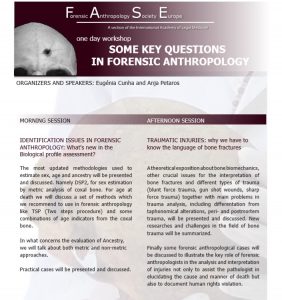Ever wondered if deciphering skeletal remains is more “CSI: Miami” glamor or grueling intellectual calisthenics? Forensic anthropology, the discipline of applying skeletal analysis and archaeological techniques to criminal investigations, might seem like a thrilling pursuit gleaned from television dramas. However, the reality of forensic anthropology classes presents a multifaceted challenge that demands a unique blend of academic rigor and practical acumen.
Let’s delve into the labyrinthine corridors of forensic anthropology education, dissecting the various aspects that contribute to its inherent difficulty. Is it the sheer volume of information, the emotionally taxing subject matter, or the intricate analytical skills required that make these classes so demanding?
The Anatomical Atlas: A Voyage Through Osteology
At the heart of forensic anthropology lies a profound understanding of the human skeleton. Students must embark on a comprehensive exploration of osteology, the study of bones. This isn’t just about memorizing names; it’s about developing an intimate familiarity with each of the 206 bones in the human body, their intricate morphologies, and their variations across populations. It’s about recognizing subtle differences that can differentiate between a male and female pelvis, or pinpoint ancestry based on cranial measurements. This requires not only rote memorization but also spatial reasoning and the ability to visualize three-dimensional structures from two-dimensional representations. The sheer volume of anatomical information can feel overwhelming, akin to navigating a dense jungle with only a tattered map.
Taphonomic Tribulations: Deciphering the Postmortem Interval
Beyond the bare bones, forensic anthropology delves into the fascinating and often unsettling realm of taphonomy. This branch of science examines what happens to remains after death. Students must learn to interpret the myriad factors that influence decomposition, including environmental conditions, insect activity, and the presence of scavengers. Estimating the postmortem interval (PMI), the time elapsed since death, is a crucial aspect of forensic investigation. This estimation involves considering a complex interplay of variables and applying sophisticated analytical techniques. Understanding advanced decomposition stages, such as adipocere formation or skeletal weathering, demands a strong foundation in biology, chemistry, and environmental science. The variability in decomposition rates and patterns adds another layer of complexity, requiring students to think critically and adapt their approaches based on specific contextual details.
Skeletal Trauma: Unraveling the Story of Injury
One of the most impactful aspects of forensic anthropology involves analyzing skeletal trauma. Students must learn to differentiate between various types of injuries, such as blunt force trauma, sharp force trauma, and projectile trauma. This requires a detailed understanding of biomechanics, fracture patterns, and the healing process. Distinguishing between perimortem trauma (occurring around the time of death) and postmortem damage is critical in determining the cause and manner of death. Furthermore, students must learn to document and interpret trauma patterns meticulously, providing crucial evidence for legal proceedings. This analysis can be emotionally challenging, as students confront the often brutal realities of violence and human suffering.
Demographic Divination: Establishing Identity
Forensic anthropologists play a vital role in identifying unknown individuals from skeletal remains. This process involves estimating the individual’s age, sex, ancestry, and stature. Age estimation techniques range from examining dental development in juveniles to analyzing degenerative changes in adults. Sex estimation relies on assessing morphological features of the pelvis and skull. Ancestry estimation involves analyzing cranial measurements and non-metric traits. Stature estimation utilizes regression equations based on long bone lengths. Each of these methods has its limitations and potential sources of error. Students must learn to apply these techniques critically, considering the limitations of each method and the potential for variation within and between populations. The goal is to create a biological profile that can be compared to antemortem records, such as medical records or missing persons databases, to establish identity.
The Legal Labyrinth: Testimony and Ethics
Forensic anthropology isn’t confined to the laboratory; it extends into the courtroom. Forensic anthropologists often serve as expert witnesses, providing testimony based on their skeletal analyses. This requires not only a strong understanding of the scientific principles underlying their work but also the ability to communicate complex information clearly and concisely to a jury. Students must learn to present their findings in an objective and unbiased manner, avoiding speculation and adhering to ethical guidelines. Furthermore, they must be prepared to defend their interpretations against scrutiny from opposing counsel. The ethical considerations in forensic anthropology are particularly important, as these professionals are entrusted with the responsibility of providing objective scientific evidence that can have profound legal and personal consequences.
A Confluence of Disciplines: The Interdisciplinary Nature
The difficulty of forensic anthropology classes also stems from their interdisciplinary nature. The field draws upon knowledge from various disciplines, including anatomy, osteology, taphonomy, archaeology, biology, chemistry, statistics, and law. Students must integrate these diverse perspectives to analyze skeletal remains effectively. For example, understanding the chemical composition of bone can aid in estimating the time since death, while knowledge of archaeological excavation techniques is crucial for recovering remains from burial sites. This requires a broad intellectual curiosity and the ability to synthesize information from multiple sources.
In conclusion, forensic anthropology classes are undeniably challenging. The combination of a vast anatomical knowledge base, the complexities of taphonomic analysis, the emotional toll of trauma interpretation, the intricacies of demographic estimation, the demands of legal testimony, and the interdisciplinary nature of the field all contribute to the intellectual rigor required. However, for those with a passion for unraveling the mysteries of the past and a commitment to justice, the rewards of this fascinating field are immeasurable. The journey is arduous, but the destination – a deeper understanding of human life and death – is profoundly worthwhile.










Leave a Comment